Report highlights. Over one-third of Americans sleep less than 7 hours per night on average, despite the recommended 7+ hours.
- Nearly 50% of American workers report feeling tired during the day due to insufficient sleep.
- 50–70 million US adults suffer from an active sleep disorder.
- Up to two-thirds of adults experience insomnia symptoms from time to time, while 10%–15% of insomnia sufferers deal with chronic insomnia.
Related reports: Sleep and stress statistics 2025
How much sleep does the average American get?
The majority of Americans get between 6 and 7 hours of sleep per night, and a sizable portion get even less. This is despite more than half of Americans (55%) saying that getting a good night’s sleep was a top priority on weekdays, ranking it above other lifestyle choices like spending time with loved ones (45%) or eating well (40%).
- A majority of Americans (53%) reported sleeping for 6–7 hours every night in 2023, while 20% said they slept for 5 hours or less.
- This number represents a significant drop from 2016, when Americans got an average of 7 hours and 52 minutes.
- Only 26% of Americans said they slept for 8+ hours per night, more than the recommended 7 hours.
- More than one-third of US adults sleep less than 7 hours per night on average.
- 33% of American adults, or 84 million people, say their sleep is “fair” or “poor,” while 35% describe it as “good,” and only 32% report getting “very good” or “excellent” sleep.
- Over 100 million Americans across all age groups say they do not get enough sleep.
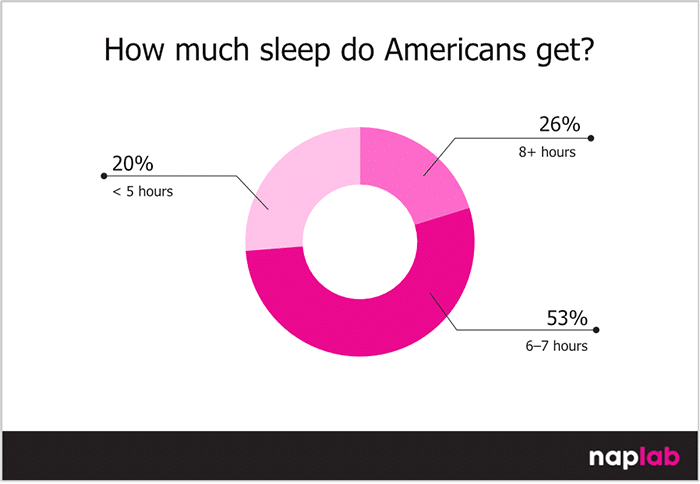
Sleep statistics by state, county, and city
Sleep duration and the share of people getting insufficient sleep vary significantly across US states, counties, and cities.
- Hawaii has the highest percentage (43.2%) of adults sleeping less than 7 hours per night, followed closely by West Virginia (42.5%) and Kentucky (42.1%).
- Vermont reports the lowest rate of insufficient sleep at 30.1%, along with Minnesota (29.1%) and Colorado (30%).
- Among US counties, 48% of adults in Greene County, Alabama slept for 7 hours or less per night in 2020, compared to 24% in Boulder County, Colorado.
- In terms of cities, Phoenix averages the lowest sleep among major US cities, at 5 hours and 42 minutes per night, followed by Atlanta (5h 45m), Dallas (5h 46m), and San Jose (5h 47m).
- Denver and Boston tie for the highest sleep duration, averaging 6 hours and 3 minutes, followed by Chicago and Washington, DC, at 6 hours and 1 minute.
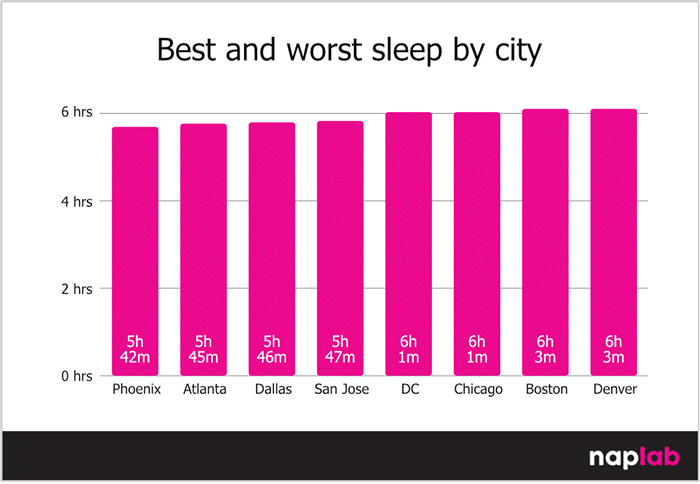
Sleep by age group or generation
Average sleep duration varies slightly across generations, and older and younger groups report more sleep than middle-aged adults.
- The Silent Generation (1928–1945) averages the most sleep at 6.97 hours per night, followed by Gen Z (2000 onwards) at 6.87 hours.
- Millennials (1982–1999) and Baby Boomers (1946–1964) sleep an average of 6.78 hours and 6.60 hours per night respectively.
- Gen X (1965–1981) reports the lowest average, with 6.54 hours of sleep per night.
Sleep statistics by gender
Sleep patterns and priorities differ slightly between men and women, from how much they sleep to what keeps them up at night. Women report facing more sleep-related issues than men.
- According to research from 2003–2007, women sleep about 11 more minutes than men.
- 60% of men report getting the recommended 7 to 9 hours of sleep, nearly the same as women (59%).
- 61% of women say that getting good sleep is important for them, compared to just 48% of men.
- 25% of women reported having issues with unwinding in the evening, compared to 13% of men.
- Likewise, fewer women (22%) than men (32%) say they have no trouble sleeping.
- Compared to men, more women report that sleep affects their mood (56% vs. 42%), workday (55% vs. 4(3%), general health (49% vs. 40%), and ability to have fun (35% vs. 26%).
- 71% of women say they’ve lost sleep to finish a book, compared to 61% of men. In contrast, 75% of men report losing sleep over sports, while only 45% of women say the same.
- Similar numbers of men and women—87% and 88% respectively—report losing sleep due to watching TV or streaming.
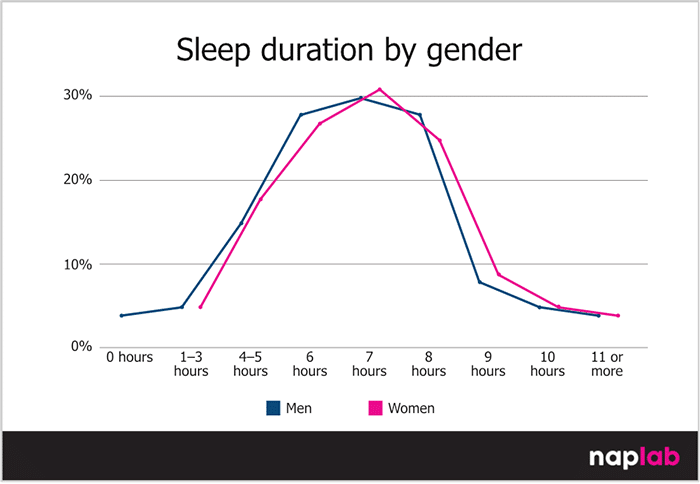
How many Americans nap every day?
It’s estimated that only 7% of Americans nap every day.
- 80.7% of US adults have taken a nap of at least 10 minutes in the past three months.
- About 30.5% of adults nap multiple times per week.
- The typical nap is reported to last around one hour, averaging 60.2 minutes.
- Nap duration decreases with age; adults aged 18–24 nap the longest, at 78.3 minutes, compared to just 63.8 minutes for adults aged 25–34, 55 minutes for adults aged 35–44, 46.9 minutes for 45–54-year-olds, and 43.4 minutes among those aged 55 and older.
- Nap duration does not correlate to nap days; Americans aged 55 and older nap the most days (135.7) in a year compared to those aged 18–24, who nap for 93.1 days.
- Adults aged 25–34 nap the least days per year, at 84.8 days.
- The average number of nap days is 94.3 days a year.
- 42.7% of full-time employees in the US report regularly taking a nap on a typical workday.
- After a nap, 52.6% Americans reported feeling groggy, while 49.1% and 38.5% reported feeling refreshed and satisfied respectively.
- Only slightly more than a quarter (25.2%) of nappers feel well-rested after waking from a nap.
- Among those who nap, 72.7% say they do so because they feel tired, while 23.1% say their napping is uncontrollable.
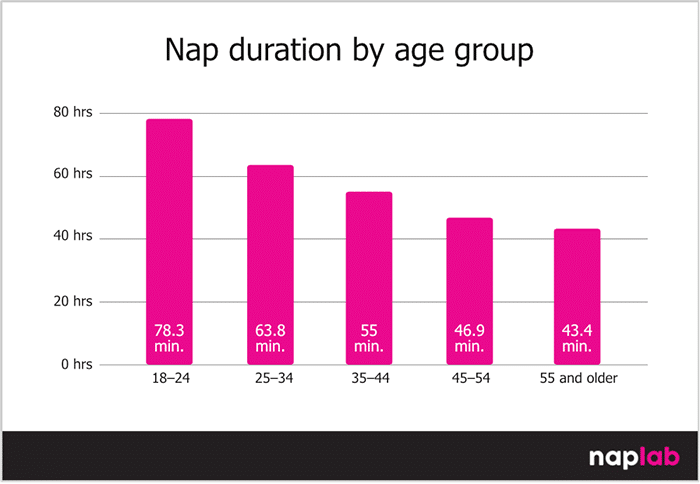
Sleep duration by countries around the world
The average amount of sleep people get each night varies only slightly by country, but residents in the Netherlands get the most sleep and those in Singapore get the least.
- People in the Netherlands slept the longest in 2016, averaging approximately 8 hours and 5 minutes per night, followed closely by New Zealand (8 hours and 4 minutes) and France (8 hours and 3 minutes).
- Australia and Belgium reported average sleep durations of 8 hours and 1 minute.
- The United States averaged 7 hours 52 minutes per night in 2016, trailing a minute behind Italy (7 hours 53 minutes) and two minutes behind the United Kingdom (7 hours 54 minutes).
- People in Singapore got the least amount of sleep in 2016, averaging just 7 hours and 24 minutes.
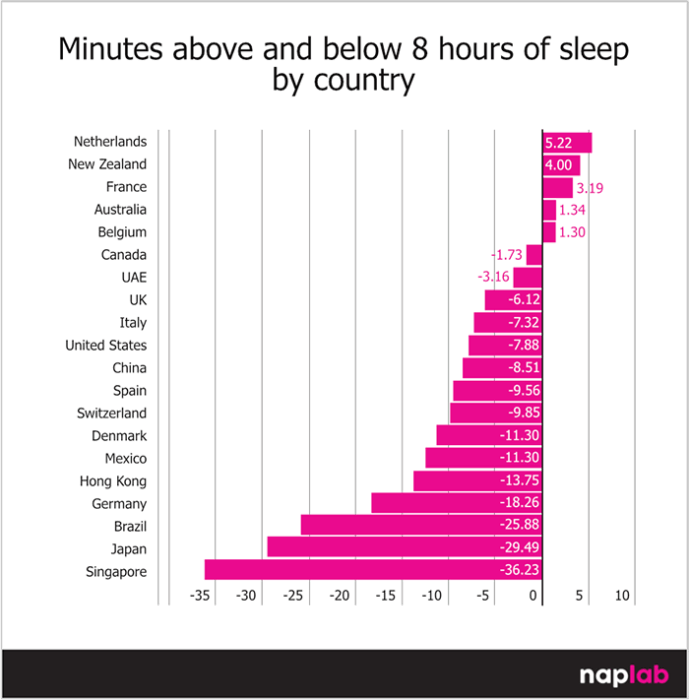
Sleep and wake times around the world
People across most countries go to bed between 10 p.m. and midnight and wake between 6:30 and 7:30 a.m. Japan and Canada fall at opposite ends of the range.
- The average American adult sleeps at 11:34 p.m. and wakes up at 7:31 a.m.
- 71% of people in the UK go to bed between 10 p.m. and 12 a.m. and wake between 7 a.m. and 8 a.m.
- Canadians sleep earlier than most, going to bed at 10:06 p.m. and waking at 6:50 a.m., according to a 2007 study.
- People in Australia, New Zealand, and Belgium have nearly identical routines, sleeping after 10:45 p.m. and waking after 6:45 a.m.
- In the UAE, people go to sleep at 11:45 p.m. and wake just before 7:45 a.m., making them among the latest risers.
- The Japanese generally go to bed between 12:10 a.m. and 12:51 a.m. and wake up between 6:44 a.m. and 7:32 a.m., depending on region and population density. This makes them the latest sleepers and earliest risers, resulting in shorter average sleep durations.
- Most people in Singapore go to sleep at 11:45 p.m. and wake up at 7:10 a.m.
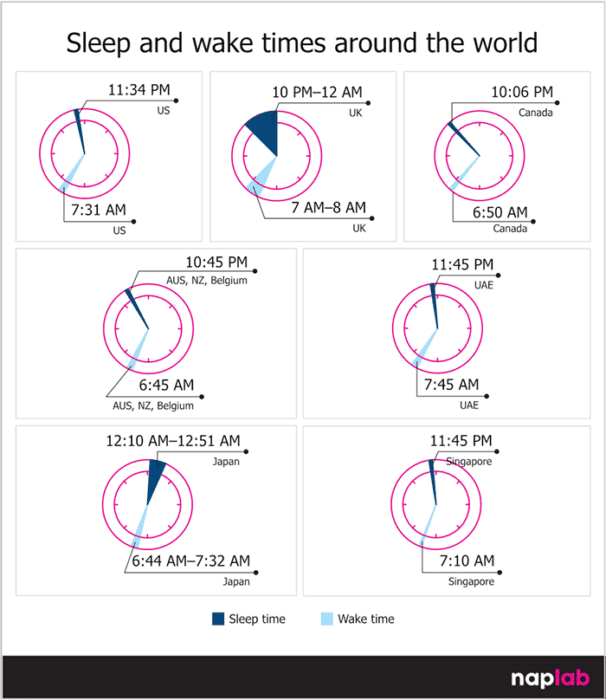
How much time does it take to fall asleep?
On average, it takes 28.6 minutes for a person to fall asleep.
- Most people (34%) report falling asleep within 16 to 30 minutes of going to bed.
- 20% of people fall asleep in 31 to 45 minutes.
- 9% take 46 to 60 minutes.
- 10% say it takes them an hour or more to fall asleep.
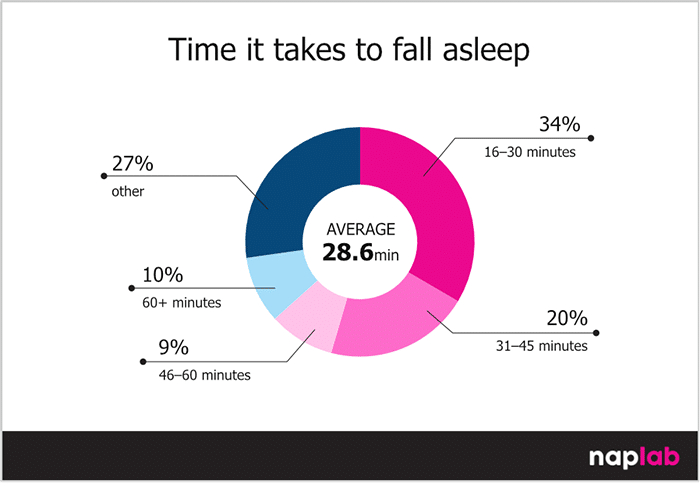
How many people suffer from sleep disorders?
Around 50–70 million US adults report having a current sleep disorder. Common sleep disorders include insomnia, sleep apnea, narcolepsy, and restless leg syndrome.
Insomnia
Insomnia affects a majority of American adults, but rates are highest among women, the elderly, and veterans. A person’s occupation (e.g., nursing) and stage of life (e.g., pregnancy) also increase the risk of developing insomnia.
- Approximately two-thirds of adults say they experience insomnia symptoms occasionally.
- 10%–15% of people report experiencing chronic insomnia.
- Gender plays a role, and women have a 40% higher chance of experiencing insomnia compared to men.
- Age is another factor, considering 75% of older adults report insomnia symptoms.
- 58% of those who served in the armed forces after 9/11 report issues with insomnia.
- 55% of nurses report insomnia symptoms.
- About half (50%) of women who are pregnant say they experience insomnia-like symptoms.
- Insomnia is connected to other disorders, including post-traumatic stress disorder. In fact, 91% of patients who have PTSD report insomnia symptoms.
- 83% of individuals living with depression are likely to exhibit at least one insomnia symptom.
- Insomnia costs the US around $31.1 billion per year on account of workplace accidents and errors.
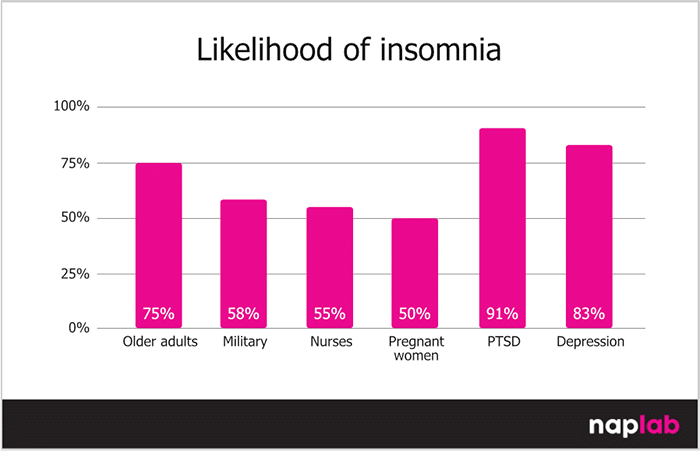
Sleep apnea and snoring
There is a strong link between snoring and sleep apnea. Snoring is widespread among Americans, reported by 72.8 million men (57%), 52.2 million women (40%), and 19.9 million children (27%).

- On average, adults in the US snore for about 24 minutes per night.
- As many as 70% of people who snore suffer from sleep apnea.
- There are three types of sleep apnea: obstructive sleep apnea (OSA), central sleep apnea (CSA), and complex sleep apnea.
- Around one billion people suffer from OSA globally. A majority of cases (80%–90%) remain undiagnosed.
- According to data from 2015, undiagnosed OSA is estimated to cost the US $149.6 billion per year, stemming from medical expenses, lost productivity, and both workplace and traffic-related accidents.
- Drivers with OSA are 2.4 times more likely to be involved in a crash compared to those without the condition.
- OSA is estimated to affect 20% of women during pregnancy.
- Fewer than 1% of people aged 40 and above suffer from CSA.
- Snoring is common in pregnancy and affects 50% of pregnant women, often increasing in severity during the third trimester.
Narcolepsy
Narcolepsy is a rare but under-diagnosed sleep disorder, most often identified between the ages of 15 and 50.
- About 44 to 50 people per 100,000 in the US are affected by narcolepsy. Rates in Europe are similar, with approximately 47 cases per 100,000 people.
- Just about 25% of people who experience narcolepsy-related symptoms are diagnosed correctly.
- Most patients tend to get diagnosed with narcolepsy at 15–50 years of age, but 15 and 36 are the common ages at diagnosis.
Other sleep disorders
Sleep issues go beyond just insomnia and apnea. Many people also experience conditions like restless legs, sleepwalking, and sleep-talking at some point in their lives.
- Around 5%–10% of adults and 2%–4% of kids in the US are affected by restless legs syndrome (RLS).
- About 6.9% of people report to have sleepwalked at least once in their lifetime.
- Children are far more likely than adults to have sleepwalked in the last year, at 5% for children and 1.5% for adults.
- The likelihood of sleepwalking in children is 47% when one parent has a history of the condition, and it rises to 61% if both parents do.
- 22% of children with parents who have no history of sleepwalking will still exhibit the behavior.
- 66.8% of people report sleep-talking at least once in their lifetime. However, only 17.7% say it occurred in the past three months, suggesting it is relatively infrequent.
What do people do before bed?
Bedtime routines vary, but most people wind down with screens, while far fewer opt for tech-free or physically active ways to relax before sleep.
- 52.7% of people watch TV or stream media before bedtime. 73.1% of them say they do so just out of habit.
- 20.4% of people read a book before bed.
- 32% of people take a shower as part of their bedtime routine, while 23.9% prefer to talk to a partner.
- Only 17.5% of people say they unplug from tech gadgets before bedtime.
- Exercise (10.6%) or yoga (9.6%) are the least commonly reported pre-bedtime activities.
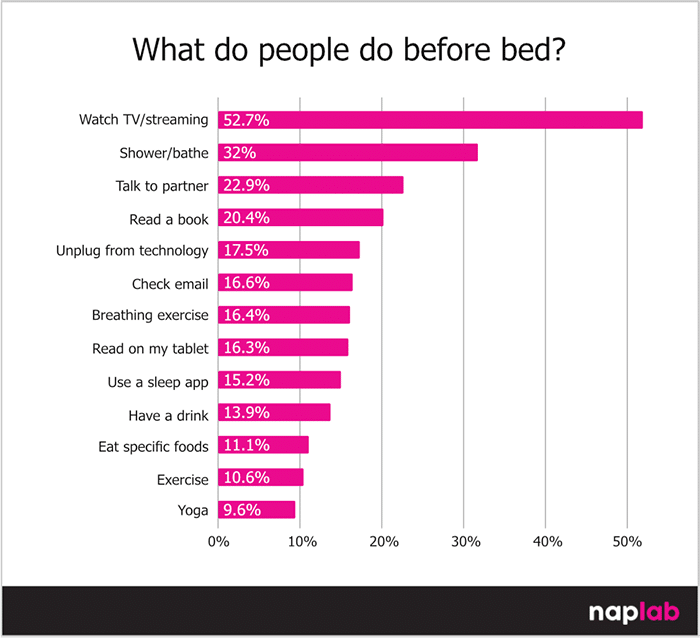
What’s keeping people from getting quality sleep?
A range of physical, emotional, and environmental factors keep many people from getting quality sleep.
- Body pain or physical discomfort is the most common barrier, cited by 39% of respondents, followed by financial worries at 36%.
- Temperature issues also played a role, including being too warm (28%) or too cold (20%) at night.
- Work-related stress and external noise were each mentioned by 18% of participants.
- A lack of sufficient darkness and children waking them were each cited by 11% of people, while 10% blamed phone notifications.
- Only 9% said they sleep well every night without any disruptions.

Mattress comfort and sleep satisfaction
Mattress quality is closely tied to how well Americans sleep because comfort and support are top priorities for most people. Data indicates the chances of a poor night’s sleep are 78% higher for those who sleep on a hard mattress.
- 92% of Americans who reported excellent sleep in the past month said they were satisfied with their mattress. In comparison, just 54% of those with poor sleep said the same.
- Comfort mattered the most when choosing a mattress, and 89% of people say it’s extremely important that it feels good to lie on.
- 77% said proper support for the spine and body was crucial.
- 51% said affordability played a big role in their choice.
- Other factors people rated as “extremely important” when choosing a mattress include sleeping at a comfortable temperature (47%), ease of purchase (38%), and use of nontoxic or organic materials (29%).
What are the effects of poor sleep?
Poor sleep can affect nearly every aspect of health, from raising the risk of disease and early death to impairing brain function, emotional control, and productivity.
- Acute sleep loss (3.6 hours of sleep) in a single night has been shown to increase blood pressure in healthy young men.
- Consistently getting only 5.6 hours of sleep per day has been shown to double reaction times and increase attention lapses by five times.
- People who sleep less than 6 hours per night have a 10% higher mortality risk compared to those who get 7 to 9 hours. Even those averaging 6 to 7 hours face a 4% increased mortality risk.
- Sleep deprivation among workers results in an estimated loss of 1.23 million workdays per year in the United States. Japan also faces a substantial impact, with around 604,000 workdays lost annually.
- Neuroimaging shows that after 35 hours without sleep, the brain reacts more strongly to negative stimuli. The emotion center (amygdala) becomes overactive and executes less control from the part that helps manage emotions (prefrontal cortex).
- People with more consistent sleep patterns had a 20% to 48% lower risk of dying from any cause, 16% to 39% lower risk of cancer-related death, and 22% to 57% lower risk of death from fatal heart or metabolic conditions.
- According to a 2023 study, poor sleep in teens, especially from internet overuse, may lead to brain injury, with a 20% increase in brain damage markers after one full night without sleep.
- Americans who slept less than 7 hours on weekdays had a 21% rate of moderate to severe depressive symptoms, compared to 7% among those sleeping 7 to 9 hours.
- Notably, sleeping more than 9 hours was also linked to a higher rate of depressive symptoms at 13%, suggesting that excessive sleep may also contribute to poor mental health.
Sleep and stress statistics
For more detailed research, read our report on Sleep and Stress Statistics.
Data from 2023 shows that sleep duration is declining and stress is on the rise. Only 26% of Americans get 8 or more hours of sleep and nearly half report frequent stress.
- In 2023, only 26% of Americans reported getting 8 hours or more sleep per night, down from 34% in 2013.
- 53% of Americans reported getting 6–7 hours of sleep per night, a slight increase from 51% in 2013.
- 20% got less than 5 hours of sleep compared to just 14% in 2013.
- Meanwhile, 49% of Americans experienced frequent stress in 2023, up from 44% in 2017.
- 53% of women said they felt stressed, compared to 45% of men.
Sleep improvement statistics
Over half of Americans have tried at least one strategy to improve their sleep. These include relaxing activities like reading, watching TV, or listening to music, as well as sleep aids such as prescription medications, CBD, herbal teas, and noise machines.
- 71% of US adults say they have tried reading before bedtime.
- 61% of people say they watch TV to help them sleep, though it may not always be effective because 50.4% of those who do report getting less than 7 hours of sleep.
- 58% of people resort to therapy for sleep apnea to improve sleep quality.
- 52% of people say they listen to soothing music and the same percentage report setting a consistent sleep and wake schedule.
- 42% of Americans choose over-the-counter sleep aids or drugs, while 29% go for prescription medicines.
- Sleep-related products are popular as well; 29% choose specialized bedding like mattresses, 26% opt for sunrise alarm clocks, 25% use ambient white noise or sound machines, and 24% go for sleep trackers.
- Natural or alternative remedies such as CBD oil and marijuana are also gaining popularity, and each are explored by 15% of people to help them sleep.
For more detailed research, read our report on Sleep Aid Statistics & Trends.
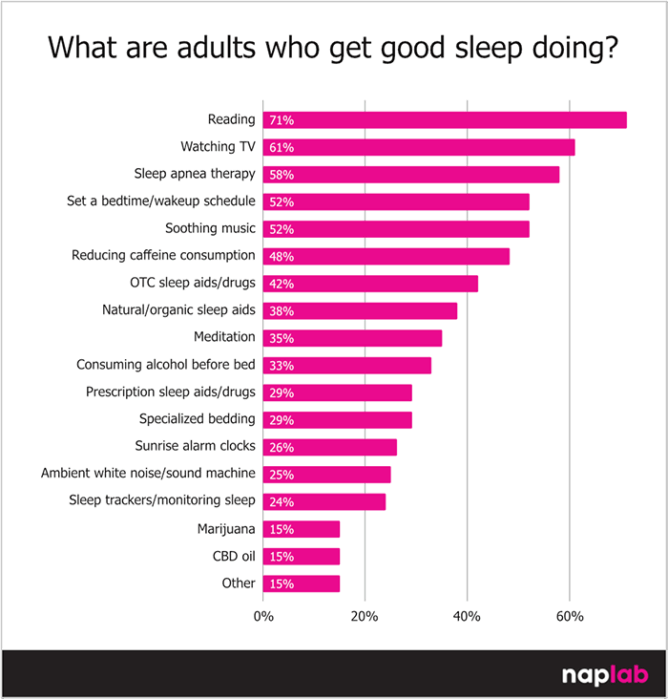
How to improve sleep
Improving your sleep often starts with small, practical changes to your routine and environment.
- Stick to a consistent sleep schedule by going to bed and waking up at the same time every day, including weekends. A review of 41 studies published in 2020 found that late bedtimes and inconsistent sleep schedules were linked to poorer sleep quality.
- Create a sleep-friendly environment by keeping your room dark, quiet, and cool. Try using blackout curtains, wearing earplugs, and ensuring adequate ventilation.
- Aim to have dinner about three hours before bedtime to allow time for digestion.
- Invest in a good mattress, pillow, and comfortable bedding to ensure proper support and create a more relaxing sleep environment.
- Avoid screens for at least an hour before bed, since blue light and mental stimulation from devices can make it harder to fall asleep.
- Get regular exercise during the day, but avoid working out too close to bedtime to help your body wind down more easily.
- If you choose to nap, keep it to around 20 minutes in the early afternoon to avoid disrupting your nighttime sleep.
- Get plenty of natural light during the day, especially in the morning, to support your body’s internal clock. A 2022 study found that bright light exposure during the day can improve both sleep quality and duration.
- Consider taking a supplement to help with sleep, such as melatonin, magnesium, or valerian, if you’re looking for additional support. Check with your healthcare professional first. Start with a low dose and try one at a time.
Sources
- 50+ sleep deprivation statistics for 2025
- Sleep statistics: Men vs. women (2022)
- Sleep habits & sleep statistics (2022)
- Sleep aid statistics & trends (2022)
- 100+ sleep statistics – Sleep Foundation
- The state of sleep in America
- Americans sleeping less, more stressed
- Sleep disorders
- The six types of sleep disorders
- Why can’t Hawaii sleep? And what makes the top states for sleep so good?
- FastStats: Sleep in adults
- 20 sleep-deprived cities in America
- Who’s napping, how long, and what does it mean for our health?
- Kiwis out-slumbered by Dutch despite more than eight hours of sleep
- Mr and Mrs US sleep cycle 2022
- Gender and time for sleep among US adults
- The YouGov Sleep Study: Part one – Sleeping patterns
- New study finds many Canadians are sleep deprived
- Australians go to bed the earliest
- Kyoto Pref. residents wake up the latest in Japan: sleep app co.
- World Sleep Day: 5 interesting trends about Zzz
- What are the types of sleep apnea?
- Central sleep apnea
- Hidden health crisis costing America billions
- New campaign to raise awareness that sleep apnea is ‘more than a snore’
- American Academy of Sleep Medicine: Obstructive sleep apnea
- Risk of motor vehicle accidents in obstructive sleep apnea: Comparative analysis of CPAP versus surgery
- What is the prevalence of narcolepsy?
- Restless legs syndrome
- Prevalence of sleepwalking: A systematic review and meta-analysis
- Prevalence of different parasomnias in the general population
- Sleepwalking: What is somnambulism?
- Why are we all still watching TV right before bed?
- Sleep disorders and sleep deprivation: An unmet public health problem
- The global problem of insufficient sleep and its serious public health implications
- Why sleep matters—the economic costs of insufficient sleep
- The state of sleep health in America 2023
- Sleep regularity is a stronger predictor of mortality risk than sleep duration: A prospective cohort study
- Sleep deprivation: Symptoms, treatment, and effects
- Top 15 proven tips to sleep better at night
- How to fall asleep faster and sleep better
- Is eating before bed bad for you?
- 20 tips for how to sleep better
- The human emotional brain without sleep—a prefrontal amygdala disconnect


